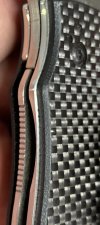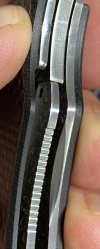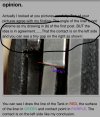I am not showing off, if you have a question, I'll try to answer, UNLIKE YOU JUST BS AND OFFER NOTHING. You want to talk gun smithing, we can. I promise, I will answer if I know, if I don't know, I will say I don't know. I won't be like you that giving all the BS and not answering anything.No one here can verify that you are any sort of engineer, gunsmith, knife fighter extraordinaire, or anything else. A quick search of this site shows I've made numerous folders.
I posted picture after I worked on the liner in post #17. You don't read and you just BS. Yes, I answer my question that the diagram (b) is the correct way.Two WHOLE knives? Got any pics?
Then you should be able to answer your own questions on lock angle.
I am not struggling, I did it, I expect people here to have the knowledge and give their experience.So what? No one can verify that and even if it's true, it has nothing to do with knife lock up.
Prove it. Got any pics of knives you've made? If it's so easy, why are you struggling with lock up questions?
I can tell you I look at the liner lock of a few knives that have not been touched, they all have the angle like in (b) of the first post. Do it the opposite way at your own risk. Don't cry if the blade collapse on your finger.I already addressed your false claims. Like a negative angle lock will come unlocked with pressure. That is blatantly and demonstrably false. Or "frame locks are better". Highly subjective and not necessarily true. There are a lot of variables. Variables you can't identify or explain.
Right way for WHAT? There is usually more than one "right" way in anything with knives. Again, it comes down to other details.
Frame lock is better if you hold your knife tight as it WILL push the liner lock towards the right more and further secure the blade. I don't think you get this simple idea because you NEVER even think of this.
You don't practice knife fight, that's why you never experience that when you swing or thrust the knife, occasionally the liner lock is pushed to the right and loosen the blade a little and it starts rattling. I can feel it. I know and YOU DON'T.
You address my false claim? So what is the right way? You never answer.
You don't want to waste your time explaining, but you write such a long response. I don't believe you know any of the answer. You just keep BS because I call you out. You don't know how to get out of this. SIMPLE, you think I don't know and I was wrong, just explain. Then I will stop calling your BS. I would assume people here in the Tinkering and modification section will know more than me!!!
To be more specific, if you explain why you said in post #47, I would go away and stop calling you fake. No need to answer post #1, I got the answer no thanks to here.
Last edited:










